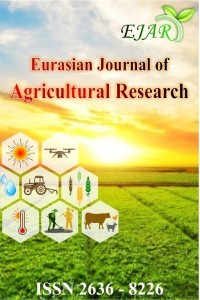Developing Silage Maize Hybrids with the Cooperation Among Public Agricultural Research Institutes of Turkey
Developing Silage Maize Hybrids with the Cooperation Among Public Agricultural Research Institutes of Turkey
Due to the need for silage maize in
livestock sector, its production in Turkey is increasing. Approximately 32% of
the total maize plantings area of Turkey is being used to produce silage maize.
Although, both public and private sector organizations released new high
yielding and quality hybrids, there is still a gap for different hybrids that
have high yield potential and good enough for different environments. To meet
the mentioned gap, collaboration between national agricultural research
institutes which have been working on maize was initiated. Silage maize inbred
lines that developed by different institutes were used in hybridization. During
hybridization studies, genetic background of the inbred lines and their yield
and quality potential was considered. Experimental hybrids and commercial
checks were tested in different locations of Turkey. Every year at least 15
experimental hybrids were evaluated in at least four locations of Turkey.
Promising hybrids were determined and used for further investigations by the
breeders. The first mutual silage maize hybrid, SAMADA-07 released in 2009.
This hybrid’s male and female parents belong to two institutions. Another
mutual silage maize hybrid AGA is now available for farmers. SASA-5 hybrid also
will be released in a near future. In this study, past and present
collaborative efforts on silage maize hybrid development by national
agricultural research centers of Turkey were presented and experiment results
from different sites were discussed.
Keywords:
Maize breeding, animal feed, variety development, yield, quality,
___
- Alfalfa Workgroup, 1998.Interpreting your forage test report. Calif Alfalfa Forage Rev. 2. Available from: http://www.foragetesting.org/files/InterpretingFQReport.pdf. 1998.
- Anonymous, 2015. TTSM Variety Cataloque. AGA variety, 62.
- AOAC, 1984. Official methods of analysis. (Centennial ed.). Washington (DC): Association of Official Agricultural Chemists.
- Aurivo co-operative, 2014. Assesing your silage report’’ http://www.aurivo.ie/wp-content/themes/aurivo/documents/assessing-your-silage-report.pdf, 2014.
- Cengiz R. 2016. Maize Research of Public Sector in Turkey, Journal Of Field Crops Central Research Institute, 25 (Special Issue-1):304-310
- Erdal S & Pamukçu M. 2011. Breeding for silage, popping and white-seeded maize hybrids for Turkey, Adressing climate change effects and meeting demands for Asia. Book of extended summaries. 11th Asian maize Conferance, Nanning, China.
- Erdal S., Pamukçu M., Ekiz H., Soysal M., Savur O., Toros A. 2009. The Determination of Yield and Quality Traits of Some Candidate Silage Maize Hybrids. Mediterranean Agricultural Sciences, 22(1): 75-81
- Erdal S., Pamukcu M., Curek M., Kocaturk M., Dogu O.Y. 2016. Silage yield and quality of row intercropped maize and soybean in a crop rotation following winter wheat. Archives of Agronomy and Soil Science, DOI:10.1080/03650340.2016.1153801.
- Geren H., Avcıoğlu R., Kır B., Demiroğlu G., Yılmaz M., Cevheri A.C. 2003. Effect of different sowing dates on the yield and quality characteristics of some maize cultivars grown as second crop for silage. Journal of Ege University Faculty of Agriculture. 40(3):57-64.
- Sahin İ.F & Zaman M. 2010. An important cattle feed: SILAGE, Eastern Geographical Review, 23: 1-17. 2010.
- TTSM 2015. Mısır [Maize], Variety Registration And Seed Certification Center. Ankara,. Available from: http://www.tarim.gov.tr.2015
- TUIK, 2016. The TUIK website. [Online]. Available: http://www.tuik.gov.tr
- Van Soest P.J., Robertson J.B., Lewis B.A 1991. Methods for dietary fiber, neutral detergent fiber, and nonstarch polysaccharides in relation to animal nutrition. Journal of Dairy Science. 74:3583–3597
- ISSN: 2636-8226
- Yayın Aralığı: Yılda 2 Sayı
- Başlangıç: 2017
- Yayıncı: Muhammed Cüneyt BAĞDATLI
Sayıdaki Diğer Makaleler
Gülcan YALÇIN TANTEKİN, Nizamettin TURAN
Identification of Ecological Connectivity for Brown Bears: Example of Malatya Province
Bekir Necati ALTIN, Derya KAHVECİOĞLU
Gökhan BÜYÜK, Ceren Ayşe BAYRAM, Muzaffer KIRPIK, Ahmet ÇELİK, Armağan KAYA, Erhan AKÇA, Halil İbrahim OĞUZ
Şule SARIÇAM, K. Yaprak KANTOĞLU, Ş. Şebnem ELLİALTIOĞLU
Molecular Identification, Virulens and Genetic Diversity of Fusarium species on Wheat
Filiz ÜNAL, F. Sara DOLAR, Nasibe TEKİNER, Nergiz Zeynep YEĞİN
Comparison of Some Chemical Properties of Amik, Gavur and Golbasi Lakes Soil’s
Ahu Alev ABACI BAYAN, Kadir YILMAZ
The Analysis of Problems in the Certification Application in State Forestry Administration in Turkey
